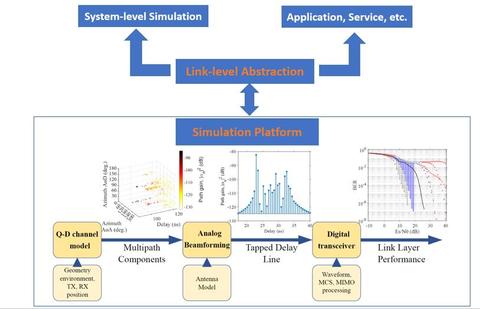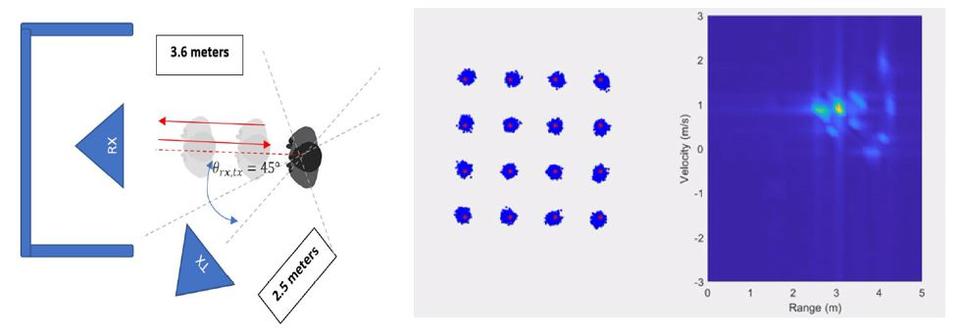Summary
Exploring mmWave in next-generation communications has created exciting opportunities to support high throughput and ultra low latency applications. However, it also raised new challenges, such as high propagation loss, prone to link blockage, and more sparse channels compared to sub-6GHz systems. The physical layer is the lowest layer in the wireless communication protocol stack, which directly handles bit-level transmission and reception over wireless channels. In this project, NIST uses measurement-based channel models in the design, development, and evaluation of next-generation wireless communications systems.
Description
IEEE 802.11ay Physical Layer Modeling and Simulation

NIST has developed models and simulation frameworks to evaluate the physical layer performance of IEEE 802.11ay under different channel environments based on real measurements. NIST IEEE 802.11ay EDMG Physical Layer Mode, implemented in MATLAB, provides an end-to-end simulation platform, including transmitter and receiver with the following features:
- IEEE 802.11ay Single Carrier/OFDM waveform generation.
- IEEE 802.11ay spatial multiplexing schemes: SU-SISO, SU-MIMO, and MU-MIMO.
- Evaluation of link-level bit error rate, packet error rate and spectra efficiency.
- Receiver algorithms supported: synchronization, channel estimation, channel equalization, and carrier frequency offset detection and correction, among others.
Built upon physical layer simulation, link-level abstraction has also been designed to support system level simulation for the IEEE 802.11ay communication systems.
More details can be found in the references below:
[1] A. Bodi, J. Zhang, J. Wang, C. Gentile, “Physical-Layer Analysis of IEEE 802.11ay based on a Fading Channel Model from Mobile Measurements,” in Proc. of 53rd IEEE International Conference on Communications (ICC), May 2019 Physical-Layer Analysis of IEEE 802.11ay SU-MIMO using the Quasi-Deterministic Channel Model with Measurements | NIST
[2] J. Zhang, S. Blandino, N. Varshney, J. Wang, C. Gentile, Nada Golmie, “Multi-User MIMO Enabled Virtual Reality in IEEE 802.11ay WLAN,” in Proc. of 2022 IEEE Wireless Communications and Networking Conference (WCNC), April 2022 https://www.nist.gov/publications/multi-user-mimo-enabled-virtual-reality-ieee-80211ay-wlan
[3] N. Varshney, J. Zhang, J. Wang, A. Bodi, and N. Golmie, “Link-Level Abstraction of IEEE 802.11ay based on Quasi-Deterministic Channel Model from Measurements,” 2020 IEEE 92nd Vehicular Technology Conference: VTC2020-Fall, October/November, 2020 Link-Level Abstraction of IEEE 802.11ay based on a Multi-Path Fading Channel Model from Measurements | NIST
[4] J. Wang, N. Varshney, J. Zhang, D. Griffith, N. Golmie, “Deep Learning Based Link-Level Abstraction for mmWave Communications,” in Proc. of 2021 IEEE Smart World Congress, October 2021 https://www.nist.gov/publications/deep-learning-based-link-level-abstraction-mmwave-communications
[5] S. Blandino, J. Senic, C. Gentile, D. Caudill, J. Chuang and A. Kayani, "Markov Multi-Beamtracking on 60 GHz Mobile Channel Measurements," in IEEE Open Journal of Vehicular Technology, vol. 3, pp. 26-39, 2022, doi: 10.1109/OJVT.2021.3138697. Markov Multi-Beamtracking in SU-MIMO with 60 GHz Mobile Channel Measurements | NIST
Integrated Sensing and Communication
Sensing is an integral part of next-generation communication networks, essential for enabling smart Internet of Things (IoT) applications. While the wireless waveform conveys information to the intended receiver, the same waveform can be used as an illuminator to perform sensing by collecting and analyzing the signals reflected or scattered from the target and the environment. However, there are tradeoffs between sensing and communication. In this project, joint sensing and communication performance is being evaluated and optimized by leveraging NIST target measurement data and models.

More details can be found in the references below:
[1] J. Wang, N. Varshney, C. Gentile, S. Blandino, J. Chuang, and N. Golmie, “Integrated Sensing and Communication: Enabling Techniques, Applications, Tools and Datasets, Standardization, and Future Directions,” submitted to IEEE Internet of Things Journal, 2022.
[2] S. Blandino, T. Ropitault, A. Sahoo and N. Golmie, “Tools, Models and Dataset for IEEE 802.11ay CSI-based Sensing,” 2022 IEEE Wireless Communication and Networking Conference.
[3] Integrated Sensing and Communication Physical Layer Model (ISAC-PLM), [Online]. Available: https://github.com/wigig-tools/isac-plm
[4] T. Ropitault, S. Blandino, N. Varshney, and N. Golmie, "Q-D simulation & Modeling framework for sensing", IEEE Std. IEEE 802.11-21/0746r1, 2021.
[5] S. Blandino, T. Ropitault, N. Varshney, J. Wang, J. Senic, J. Chuang, C. Gentile, and N. Golmie, "DMG/EDMG Link Level Simulation Platform", IEEE Std. IEEE 802.11-22/0803r0, 2022

